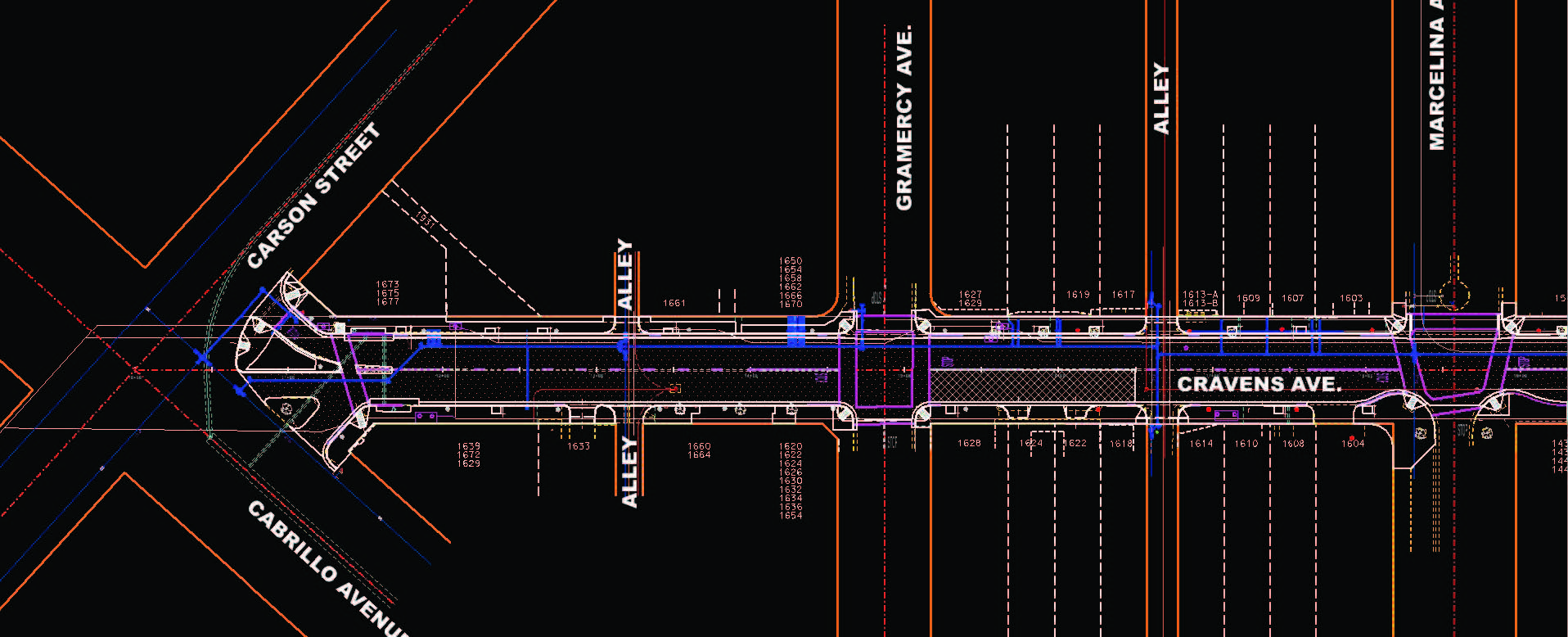Project
When the City of Torrance, California decided it was time for a facelift to a section of Cravens Avenue in the historic downtown area, it was much more than a simple repaving project. The area, affectionately known as “Old Torrance,” was designed in 1912 by Frederick Law Olmsted, Jr., making the street over 100 years old. There were also significant sidewalk issues that presented safety hazards, so it was time for a major refresh. The city’s vision was to create an “inviting and more unified pedestrian atmosphere”— while bringing the area into compliance with current Americans with Disabilities Act (ADA) standards.
The job was awarded to JMC2 Engineering out of San Pedro. President and CEO John Cruikshank says, “Because of the age of the area, ADA compliance was not anticipated, so there were major issues. Many of the tripping hazards were caused by old trees whose root systems were pushing sidewalks, streets, driveways, and curbs upward. Plus, the street was very wide and bland.”
JMC2’s goal was to develop the project around community needs by creating inviting spaces, safe crosswalks, wayfinding, and code-compliant functionality. That required a careful analysis and roadway design plan first.

The Cravens Avenue basemap generated in Bentley’s MicroStation
(Image: Courtesy of JMC2 Engineering)
Solution
JMC2 began the design process by using Bentley’s OpenRoads Designer, a comprehensive roadway design application. “We used the software to import our survey field data to develop 3D topography surfacing,” says Cruikshank. “We were in full command of project analysis and roadway design once we modeled the Cravens Avenue sidewalk and roadway surfaces.”
The project involved a complete rebuild of all driveways, sidewalks, drainage systems, water lines and street lighting. “To bring this street up to current ADA standards, the design team needed a highly accurate 3D design model,” he adds. “We needed OpenRoads Designer to analyze and plan joining of sidewalks to old building thresholds and to add ADA curb ramps at every street corner.”
The Torrance city arborist conducted a street tree inventory and identified which trees should be removed. It was decided that all large trees adjacent to sidewalks needed to be removed in order to be ADA-compliant. New trees were planted in their place. “We opened up 5-square-foot tree wells for better growth and side- walk protection,” says Cruikshank.
Bentley’s MicroStation was used for the core drafting tasks, including civil CAD basemap development, file referencing, and plan sheet creation. “This was essential to preparing our plans to the City of Torrance’s stringent CAD standards,” explains Cruikshank. “We even provided the city with the Bentley View product so they could open and review our design files quickly, and at no cost to them.” For modeling water flow and pipe sizing, JMC2 used Bentley’s OpenFlows to produce a digital twin of the replacement water system along the half-mile stretch of Craven Avenue under redesign. This system is used both for fire suppression waterflow and for potable domestic water needed by commercial and residential users and within the famous El Prado Park.
Outcome
The City of Torrance had high standards. Cruikshank says, “The project manager was very particular about the way under-walk drains, driveways, ramps, utility vaults, alley aprons, door entryways and trees were shown on the plans. MicroStation allowed our engineering team to use precise line work, hatching, and text callouts to make the plans easy to read and follow.”

Improvements to pedestrian walkways, ensure safety while maintaining the town’s charm.
(Image: Courtesy of JMC2 Engineering)
All design work was done in one civil basemap CAD file, then referenced in each individual plan sheet. The file exchange utility allowed easy transfer of information back-and-forth between the basemap and the sheet files, which saved JMC2 considerable amounts of time.
The firm’s explanation of the Old Torrance downtown pedestrian improvement project also emphasizes the benefits of being able to work remotely during a pandemic: “Work was completed right when the State of California ‘Safer at Home’ orders were being issued for the COVID-19 outbreak. Client coordination was possible by working remotely since Bentley design files and models can be made compact and efficient.”
Not only was design time reduced by 20 percent, but Cruikshank estimates his firm saved about $50K in costs over prior design methods, a cost savings that was passed back to the client. Furthermore, JMC2 never had to go out to the construction site to respond to constructability questions.
Software
Facts
- The project involved a rebuild of all
driveways, sidewalks, drainage systems,
water lines, and street lighting. - To address ADA compliance issues
large trees adjacent to sidewalks were removed. - MicroStation was used for the core
drafting tasks, including civil CAD
basemap development, file referencing, and plan-sheet creation.
 "The project manager was very particular about the way underwalk drains,
"The project manager was very particular about the way underwalk drains,
driveways, ramps, utility vaults, alley aprons, door entryways, and trees were
shown on the plans. MicroStation allowed our engineering team to use precise line work, hatching, and text callouts to make the plans easy to read and follow.”
John Cruikshank
President and CEO
JMC2 Engineering


